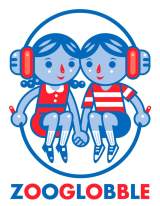Review: Happy Lemons - Ralph's World
 Sunday, October 2, 2005 at 1:40PM
Sunday, October 2, 2005 at 1:40PM By the time Ralph Covert recorded his third children's album, Happy Lemons, he pretty much had the Ralph's World formula down pat:
1. Start with some uptempo originals.
2. Scatter a few covers, children's and otherwise, into the mix.
3. Use a few different musical styles.
4. End with a sappy song that's kinda nice in spite of itself.
And so it is with Happy Lemons. Heck, on the peppy title track, which leads off the album, Covert shares songwriting duties with his elementary-aged daughter Fiona. (Of the two father-daughter penned tracks on the album, I prefer the midtempo rocker "Puddle of Mud," which, aside from the lyrical content, would sound OK on modern adult contemporary radio.) "Pony Boy" is a bit draggy for my tastes, but his version of "The Muffin Man" is very energetic, the best I've heard. "Clean Up" is a reggae song, complete with horn section. And "Riding With No Hands" is another standard-issue closing sappy song. Covert is by no means alone among kids' recording artists in ending his CDs with a slower, sweet song, but he may be the most shameless practitioner.
For me, a little something is missing from this album -- there's no absolute "you have to hear this one" song like there was on his previous CDs ("Eighteen Wheels on a Big Rig" still -- annoyingly -- runs through my brain). But all in all, it's another solid album, and if you like the other Ralph's World CDs, you'll like (or at least tolerate) this one. Best for ages 4 through 7. Found at most major bookstores and online purveyors of media. You know the ones. Recommended.



 The folksinger Woody Guthrie was a prolific songwriter. Best known as the composer of "This Land is Your Land," Guthrie wrote and wrote and wrote. (Billy Bragg and Wilco combined to make two enjoyable Mermaid Avenue CDs in which they took songs from his large store of unreleased lyrics and added new melodies.) In addition to writing many songs with a more political bent, he also released a couple kids’ albums in the mid-1950s. Both these albums have been released on CD by Smithsonian Folkways records.
The folksinger Woody Guthrie was a prolific songwriter. Best known as the composer of "This Land is Your Land," Guthrie wrote and wrote and wrote. (Billy Bragg and Wilco combined to make two enjoyable Mermaid Avenue CDs in which they took songs from his large store of unreleased lyrics and added new melodies.) In addition to writing many songs with a more political bent, he also released a couple kids’ albums in the mid-1950s. Both these albums have been released on CD by Smithsonian Folkways records. The Elvis of children's music would have to be Raffi. His own "Behind the Music" episode wouldn't be nearly as interesting as, say, Motley Crue's. But the category of "children’s music" didn’t exist in record stores before Raffi -- and this CD -- came along.
The Elvis of children's music would have to be Raffi. His own "Behind the Music" episode wouldn't be nearly as interesting as, say, Motley Crue's. But the category of "children’s music" didn’t exist in record stores before Raffi -- and this CD -- came along.